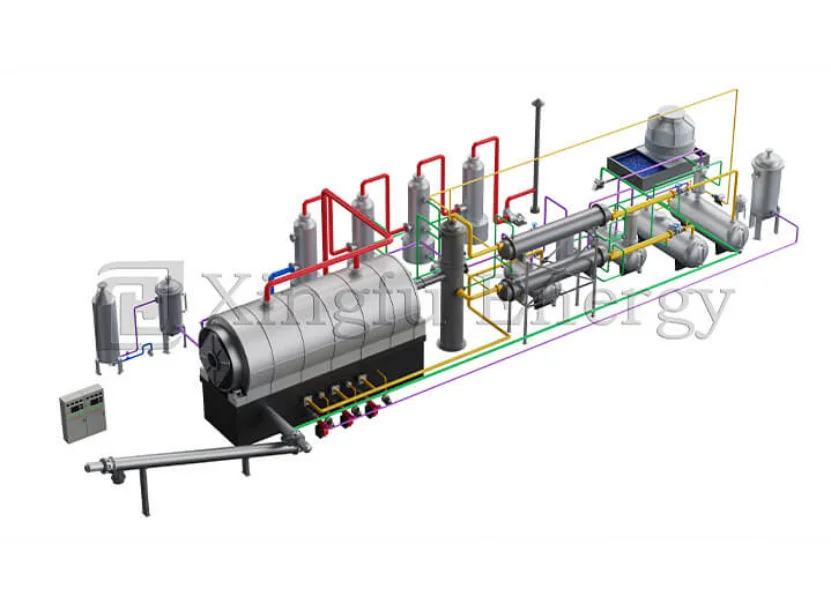Pyrolysis is a heat-driven process that breaks down organic matter at high temperatures without oxygen. It works well for handling plastic waste. The method turns plastics into useful items like fuel oil, gas, and char. Plastic pyrolysis is growing popular. It’s a fresh way to tackle the increasing problem of plastic buildup.
Plastic pyrolysis brings several pluses over usual recycling ways. It shrinks the amount of plastic waste a lot. It also changes hard-to-recycle plastics into handy products. This helps recover energy and save resources. Another perk is it can deal with mixed plastics. No need for heavy sorting.

Mechanical recycling often leads to lower-quality goods. Pyrolysis, though, breaks plastics back into their basic chemical parts. This gives higher-quality results. Incineration pumps out nasty fumes. Pyrolysis, if managed right, avoids that. It runs without oxygen, making it kinder to the environment.
Plastic pyrolysis happens at hot temperatures, usually from 350°C to 700°C. No oxygen is around to stop burning. This lets long polymer chains split into smaller bits. The heat level matters a lot. It decides how well the process works and how much product comes out.
Catalysts give a big lift to pyrolysis. They cut the energy needed to start reactions. They also speed things up. Plus, they can steer the process toward certain outputs. This means more of the liquid oil or gases you want.
Different reactor styles fit pyrolysis needs. Each has its own traits that affect heat flow and product amounts. You’ve got batch reactors, continuous reactors, and fluidized bed reactors. Which one gets used depends on stuff like feedstock type, operation size, and what products you’re after.
The top output from plastic pyrolysis is liquid oil. This can be turned into fuels like diesel or gasoline. It’s a backup energy source. Uses include diesel motors (high power, low rotating rate), heating furnaces, metal work, and industrial ovens.
Pyrolysis kicks out gases too, like syngas. That’s a blend of hydrogen and carbon monoxide. Syngas can heat things or make electricity right in the plant. This cuts down on outside energy needs and boosts efficiency.
Besides oil and gases, pyrolysis makes other useful stuff like waxes. What you get depends on the feedstock and setup. Char leftovers can stand in for carbon black or improve soil after some treatment. With plastics like PVC, you might also pull out hydrochloric acid (HCl).

How well plastic pyrolysis works ties closely to heating speed and temperature. Fast heating pushes out more gas. Slower heating leans toward liquid oil. Temperature shapes the product mix too. Plastic pyrolysis runs at high heat, from 350°C to 700°C. This breaks long polymer chains into smaller pieces. Tweaking these settings can tune the process. You can aim for more oil or more gas, depending on what’s needed.
Pressure and residence time play big roles too. Higher pressure can speed up breaking things down. But it might need tougher gear to handle the strain. Residence time is how long stuff stays in the reactor. Longer times mean fuller reactions. Plastics turn more completely into wanted products. Still, you’ve got to weigh that against energy use and how much you can process at once.
Plastic pyrolysis has tons of promise. But it faces hurdles that slow it down. One big snag is feedstock variety. Plastics break down differently depending on their type. This messes with process conditions and steady outputs. Catalysts help a lot here. They lower startup energy and speed reactions. Finding cheap, strong catalysts is still a work in progress, though.
Another hitch is reactor design. Different setups—like batch, continuous, or fluidized bed reactors—handle heat and yields in their own ways. Building reactors that max out efficiency and cut energy use is key. It’s a big step for pushing this tech forward.
Rules and eco-worries shape how pyrolysis spreads too. Sticking to emissions limits is a must. It keeps harmful stuff from leaking out during the process. Pyrolysis avoids bad emissions if run tight. Keeping that control is critical for safety.
Looking ahead, plastic pyrolysis needs more work to beat these issues. New ideas in catalysts, reactor builds, and feedstock prep can lift efficiency. They can also drop costs. Matching rules to tech breakthroughs will help too. It’ll make this green waste fix more welcome.
The top perk is turning tough-to-recycle plastics into useful fuels. It also cuts environmental harm compared to old-school recycling.
Heat affects both how well it works and what you get. Higher temps boost gas output. Moderate ones favor liquid oil.
You see batch reactors for small runs. Continuous and fluidized bed reactors fit bigger jobs needing steady quality.
Most thermoplastics work fine without sorting first. Their heat breakdown is similar. But some additives might need extra care during processing.
For more on how our services can fit your waste management needs with tech like plastic pyrolysis, contact us today!